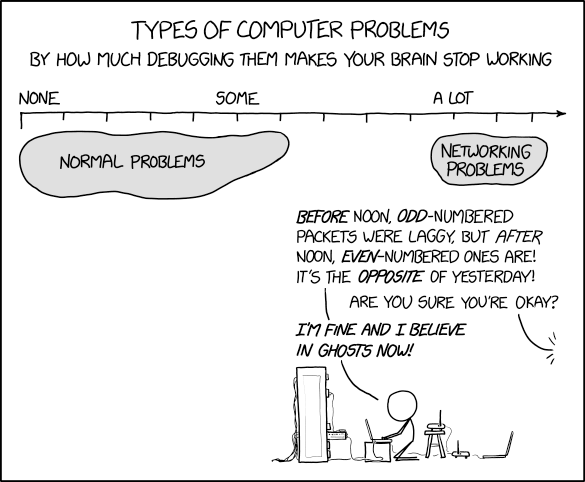When your code is terrible but it somehow works.
by u/quinten157 in ProgrammerHumor
Batfish is an open-source network configuration analysis tool in active development produced jointly by researchers at University of California, Los Angeles; University of Southern California; and Microsoft Research. Though its individual modules have various applications, its primary purpose is to detect bugs in network configurations. Batfish takes as input a set of network configurations, and an environment, which consists of a set of (in)active links and a set of external BGP advertisements. Users are able to ask customized queries about the control plane using Batfish’s domain-specific query language e.g. whether all loopback addresses are being advertised into OSPF, or whether all route policies attached to eBGP neighbors apply a particular community to incoming routes. Batfish also is able to compute the convergent data plane for a network, which provides further query facilities. Given the data plane, users can employ an off-the-shelf data plane checker or use Batfish’s data-plane queries to check common properties such as reachability/black holes, loops, etc, as well as novel properties (introduced at NSDI’15) regarding equivalence of multipath routes, fault-tolerance, and unique delegation of customer address space, with more to come.
When IOS XR was first designed, mass-scale networking and its related challenges were not around. However, we already had a clear vision of building a highly scalable, reliable, available, upgradeable, high-performance NOS for the service provider space that caters all the way from low-end single chassis systems to massive high-end multi-chassis routers. To meet the rigorous SP requirements, a slew of ground-breaking infrastructure and distributed-systems architecture patterns were brought into the system—decoupled plane abstractions, state management, process distribution, high-performance messaging infrastructure, data distribution/access patterns, high availability and upgradeability. These solid foundations and continuous evolutions made IOS XR the industry-leading NOS.I’m thrilled to announce today the availability of IOS XR, Release 7, that brings some noteworthy evolutions. Four key tenets make Release 7 stand out.It is simple, modern, trustworthy, and cloud-enhanced.
I wrote a small tool to help figure out the impact of deploying “RPKI invalid == reject” routing policies, since not all invalids are equally problematic. Enjoy! https://t.co/qtxs5Z46Yx pic.twitter.com/aw6CCNSLXf
— Job Snijders (@JobSnijders) February 6, 2020

Automating management of NOS’es? Heck yeh!
When we say that our MD-CLI is modelled in YANG we mean it, like, seriously.
Now its the time for YANG tooling to become more mature and language diverse. pic.twitter.com/iaCP6ojMPq
— Roman Dodin (@ntdvps) January 29, 2020